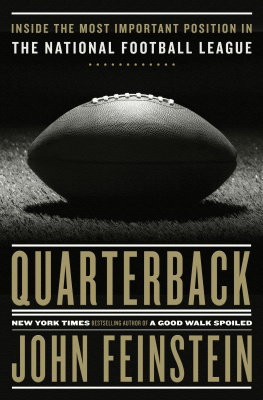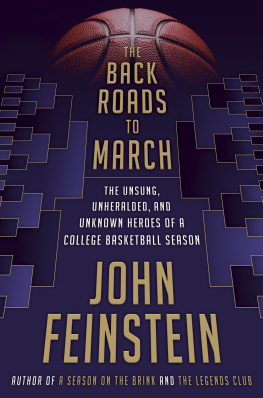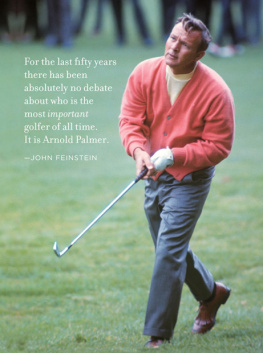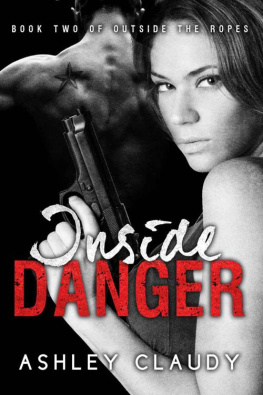John Feinstein - Open: Inside the Ropes at Bethpage Black
Here you can read online John Feinstein - Open: Inside the Ropes at Bethpage Black full text of the book (entire story) in english for free. Download pdf and epub, get meaning, cover and reviews about this ebook. year: 2003, publisher: Little, Brown and Company, genre: Detective and thriller. Description of the work, (preface) as well as reviews are available. Best literature library LitArk.com created for fans of good reading and offers a wide selection of genres:
Romance novel
Science fiction
Adventure
Detective
Science
History
Home and family
Prose
Art
Politics
Computer
Non-fiction
Religion
Business
Children
Humor
Choose a favorite category and find really read worthwhile books. Enjoy immersion in the world of imagination, feel the emotions of the characters or learn something new for yourself, make an fascinating discovery.

- Book:Open: Inside the Ropes at Bethpage Black
- Author:
- Publisher:Little, Brown and Company
- Genre:
- Year:2003
- Rating:4 / 5
- Favourites:Add to favourites
- Your mark:
- 80
- 1
- 2
- 3
- 4
- 5
Open: Inside the Ropes at Bethpage Black: summary, description and annotation
We offer to read an annotation, description, summary or preface (depends on what the author of the book "Open: Inside the Ropes at Bethpage Black" wrote himself). If you haven't found the necessary information about the book — write in the comments, we will try to find it.
Open: Inside the Ropes at Bethpage Black — read online for free the complete book (whole text) full work
Below is the text of the book, divided by pages. System saving the place of the last page read, allows you to conveniently read the book "Open: Inside the Ropes at Bethpage Black" online for free, without having to search again every time where you left off. Put a bookmark, and you can go to the page where you finished reading at any time.
Font size:
Interval:
Bookmark:

Copyright 2003 by John Feinstein
All rights reserved. No part of this book may be reproduced in any form or by any electronic or mechanical means, including information storage and retrieval systems, without permission in writing from the publisher, except by a reviewer who may quote brief passages in a review.
Hachette Book Group
237 Park Avenue
New York, NY 10017
Visit our website at www.HachetteBookGroup.com.
The Warner Books name and logo are trademarks of Hachette Book Group, Inc.
ISBN: 978-0-7595-2795-9
First eBook Edition: May 2003
ALSO BY JOHN FEINSTEIN
The Punch
The Last Amateurs
The Majors
A March to Madness
A Civil War
A Good Walk Spoiled
Play Ball
Hard Courts
Forevers Team
A Season Inside
A Season on the Brink
Running Mates (A Mystery)
Winter Games (A Mystery)
This is for Ken Denlinger and Dave Kindred. Mentors. Friends. Role models. As journalists and as people.
WHEN I FIRST began covering golf in 1993, my vision of the United States Golf Association was pretty similar to the description once offered by Lee Trevino of the typical USGA officer: Get yourself a blue blazer and some dandruff and you can be a part of the USGA, too. To me, the USGA was a bunch of rich guys with gold buttons, putting on the U.S. Open at gorgeous country clubs filled with their fellow patricians.
My stereotype received a jolt on the last day of the Open in 1994 at Oakmont. The heat in Pittsburgh that week was brutal, the humidity on the golf course thick enough to peel.
On the final afternoon, I was searching for shadethere was noneon the 11th hole when I noticed Grant Spaeth, a onetime USGA president who was on the golf course as a walking rules official. His blue USGA shirt and tie were completely soaked through, and he looked even more miserable than I felt.
You know, I said to Spaeth, it might help you guys a little bit if you wore white shirts instead of that blue.
Spaeth shook his head. No, cant do that, he said. At the USGA we like to think of ourselves as a blue-collar organization.
Now that was funny.
At that moment, I liked the USGA a little bit more.
As time went on, I found other reasons to like the USGA. One was Frank Hannigan, the former senior executive director of the organization. I have often described Hannigan as my favorite curmudgeon. He can find darkness in the sun, treachery in the sale of Girl Scout cookies. He is also as bright as they come, generous with his time and his ideas, and in spite of his inexplicable fascination with the NBA, one of my favorite people.
It was Hannigan who figured out how to get the U.S. Open played at Shinnecock, and it was the Open at Shinnecock that led to the Open at Bethpage Black. It was also Hannigan who decided to promote David B. Fay over several others to the number two position in the USGA and Hannigan who pushed for Fays hiring as his successor in 1989 when many on the executive board wanted to go outside and hire a name.
Fay looks like he would fit comfortably into a USGA blazer. He often wears a bow tie and he was educated at Colgate and Stanford. But hes also the son of a steamship captain who grew up as a caddy and played most of his teenage golf at a nine-hole municipal course. He only wears the bow tie because he has a penchant for spilling foodusually from a greasy-spoon diner because thats where hes most comfortableon the expensive ties his wife buys him.
Meeting Fay was something of a revelation to me. One of the first things he said to me was, I love golf, enjoy its traditions as much as anyone, but if you dont love baseball you have no soul.
My kind of guy. It was Fay who first decided that making caddies wear long pants in 90-degree weather was foolish, putting them in shorts for the 1998 Open. I wouldnt care if the players wear shorts when its that hot, he said, no doubt sending a tremor through the entire golf establishment.
Fay is, if nothing else, unorthodox. It was that sense of wanting to be different that led him to Bethpage. He believed the USGA needed to make some sort of statement about the importance of public golf, that it needed to get away from always staging its signature championship at havens for the very rich. He remembered the Black Course from his days as a kid and went to check on it one cold afternoon in November and came away convinced that it could be great again.
The Duke of York, credited by many with introducing golf in Great Britain, brought the game to the United States. He and his friend Thomas Powell supposedly played golf on the land that would later become Bethpage State Park in 1688. Powell, who purchased the tract of land that came to become known as Bethpage, also gave it the name.
As the area grew, it went through name changesfor a while it was called Central Park, long before Manhattans Central Park came into existenceand was passed to Powells heirs and eventually was bought early in the twentieth century by a railroad tycoon named Benjamin F. Yoakum. It was Yoakum who developed Lenox Hills, first as a housing development and then as a private golf club.
Yoakum died in 1929, shortly after the stock market crashed. As part of the Works Progress Administration program created by the government for the purpose of putting people back to work, the Yoakum estate was leased and later purchased by the state of New York. It was Robert Moses who proposed the idea of building a state park on the Yoakum estate. The name Lenox Hills was changed to Bethpage Golf Club and it was opened to the publicmuch to the horror of the membership at Lenox Hills, which sought an injunction preventing the sale of the land to the state. The injunction was denied, and eventually, the project went forward.
When the new club opened to the public in 1932, an 18-hole round cost a dollar on weekdays, two dollars on weekends. The course was so popular that Moses began making plans to build others. Within four years, three new courses had been built. Moses masterstroke was to hire the renowned golf course architect A. W. Tillinghast to design two of the coursesthe Red and the Black. To this day there is controversy about just how involved Tillinghast was in the project and just why the Black took shape as it did. There are stories claiming that Tillinghast and Moses fell out before the project was finished, thus explaining why the routing of the course and the bunkering of the course look very much like other Tillinghast designs but the greens do not. Some people speculate that Tillinghast made the greens smaller and easier because the course was part of a public park and he didnt want it to be too difficult. But given that there were three other courses at the time, the Black was clearly built to be the most challenging.
Most recently, Joseph Burbeck, the son of the parks first superintendent, David Burbeck, has claimed that it was his father who actually designed the Black Course, that Tillinghast disappeared from the project soon after it began. Joseph Burbeck was four when the clubhouse had its official opening in 1935, and there are pictures of him alongside his father, formally opening the lock to the front door of the new building.
No one disputes the elder Burbecks importance in the development of the park or that he played a major role in getting the golf courses constructed. But most Bethpagers will always see the Black as one of Tillinghasts masterpieces. From the day it opened in 1936, it was considered one of the great public golf courses and one of the best layouts anywhere. But as the years went by, even though golfers always talked about it, the course began to fade away. Lack of funds, lack of interest on the part of the state, and the constant pounding the course took because of all the play on iteven with no golf carts allowedhad beaten it down into a state of sad disrepair when David Fay had his crazy idea.
Font size:
Interval:
Bookmark:
Similar books «Open: Inside the Ropes at Bethpage Black»
Look at similar books to Open: Inside the Ropes at Bethpage Black. We have selected literature similar in name and meaning in the hope of providing readers with more options to find new, interesting, not yet read works.
Discussion, reviews of the book Open: Inside the Ropes at Bethpage Black and just readers' own opinions. Leave your comments, write what you think about the work, its meaning or the main characters. Specify what exactly you liked and what you didn't like, and why you think so.




